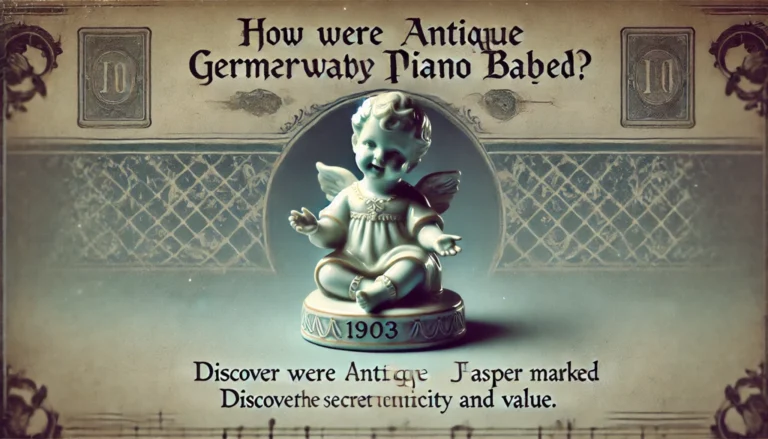
Antique collectors often marvel at the intricacy and charm of 1903 German Jasperware Piano Baby figurines. These exquisite porcelain pieces, frequently crafted with remarkable attention to detail, are aesthetically pleasing and hold historical significance. Identifying and understanding the markings on these figurines is crucial for verifying their authenticity and appreciating their value. Below, we explore the interesting world of German Jasperware Piano Babies. We will look at how they were marked and why they are a prized addition to any collection.
What Is a Jasperware Piano Baby?
Jasperware Piano Babies are porcelain figurines designed to depict infants in playful or endearing poses. Originating in the late 19th and early 20th centuries, these decorative items were commonly placed on pianos to prevent the fabric covers from sliding off. German manufacturers became renowned for producing high-quality Jasperware Piano Babies, which were prized for their artistic detail and fine craftsmanship.
The Historical Roots of German Jasperware
German Jasperware has a storied history that traces back to the 18th century, with its production reaching new heights in the 19th and early 20th centuries. By 1903, manufacturers were creating figurines that epitomized elegance and sophistication. These figurines were often adorned with distinctive marks, allowing collectors to identify their origins.
How Were Antique 1903 German Jasperware Piano Babies Marked?
The process of marking these figurines was meticulous, serving as a way to verify authenticity and ensure traceability. Here are some common methods and features associated with these marks:
1. Manufacturer’s Mark
Most 1903 German Jasperware Piano Baby figurines bore a manufacturer’s mark, which often included the company’s name, logo, or initials. Depending on the manufacturer, these marks could be:
- Stamped: Imprinted during the production process.
- Engraved: Carved into the figurine’s surface.
- Hand-painted: Applied by skilled artisans, typically in gold or cobalt blue.
2. Numerical Codes
Many figurines featured numerical codes or serial numbers, which could indicate the production year, model type, or series. These codes are invaluable for collectors to determine a piece’s age and origin.
3. Distinctive Symbols
German manufacturers frequently used distinctive symbols such as crowns, shields, or flowers to signify their brand. These symbols were often combined with letters or initials to create a unique identifier.
Why Are Markings Important?
The markings on antique 1903 German Jasperware Piano Babies provide valuable insights into their history and authenticity. Here’s why they matter:
- Verification of Authenticity: Genuine markings help collectors avoid purchasing counterfeit pieces.
- Historical Context: Marks can reveal the time and manufacturer, adding to the figurine’s narrative.
- Assessment of Value: Rare pieces with intact markings are more valuable in the collector’s market.
Famous German Manufacturers and Their Marks
1. Heubach
One of the most renowned producers of Jasperware Piano Babies, Heubach was celebrated for its lifelike designs. Heubach figurines often featured a sunburst logo or the company name engraved beneath the base.
2. Gebrüder Knoch
Another prominent manufacturer, Gebrüder Knoch, used unique marks such as intertwined initials or floral emblems. Their figurines are known for their delicate craftsmanship and vibrant coloring.
3. Conta & Boehme
Conta & Boehme figurines are easily recognizable by their shield mark accompanied by the company’s name. They specialized in creating whimsical and playful designs.
Tips for Collectors to Verify the Authenticity of German Jasperware
1. Inspect the Markings Carefully
Examine the base and other inconspicuous areas of the figurine for manufacturer’s marks, numerical codes, or symbols. These markings can provide critical information about the piece’s authenticity and origin.
2. Research the Manufacturer
Familiarize yourself with the distinctive marks of notable German manufacturers. Historical records and collector’s guides can offer detailed descriptions and examples.
3. Avoid Counterfeits
Counterfeit figurines often feature poorly executed markings or entirely lack them. Be cautious of pieces with blurred or irregular stamps.
4. Seek Expert Appraisal
If you are unsure about a figurine’s authenticity, consult a professional appraiser or an experienced collector. Their expertise can help you identify genuine 1903 German Jasperware Piano Baby figurines.
The Allure of Antique Jasperware Piano Babies
The charm of antique Jasperware Piano Babies lies in their combination of artistry, history, and rarity. These figurines not only serve as decorative items but also as tangible connections to the craftsmanship of the past. For collectors, understanding the markings on these pieces adds an extra layer of appreciation, making each acquisition a journey into history.
Conclusion
The markings on 1903 German Jasperware Piano Babies are more than just symbols; they are keys to unlocking the rich history and authenticity of these cherished antiques. By learning to identify and interpret these marks, collectors can navigate the world of Jasperware with confidence and precision.
(FAQs) about antique 1903 German Jasperware Piano Babies:
1. What are Jasperware Piano Babies?
Jasperware Piano Babies are porcelain figurines designed to resemble infants in playful or endearing poses. They were often used as decorative items on pianos during the late 19th and early 20th centuries.
2. Why are 1903 German Jasperware Piano Babies significant?
These figurines represent a blend of exquisite craftsmanship and historical value. They were produced during a peak era of porcelain artistry and are highly sought after by collectors for their quality and intricate designs.
3. How can I identify the markings on a 1903 German Jasperware Piano Baby?
Look for manufacturer’s marks, numerical codes, or distinctive symbols on the base or hidden parts of the figurine. These markings often include logos, initials, or serial numbers that help verify authenticity and origin.
4. What are some common marks used by German manufacturers?
Renowned manufacturers like Heubach, Gebrüder Knoch, and Conta & Boehme used marks such as sunbursts, shields, crowns, or floral emblems. These marks can also include the manufacturer’s name or initials.
5. How can I verify the authenticity of a Jasperware Piano Baby?
- Examine the markings for clarity and accuracy.
- Compare the mark with known examples from reputable sources.
- Consult a professional appraiser or experienced collector for evaluation.
- Be wary of counterfeits, which may lack proper markings or show poor craftsmanship.